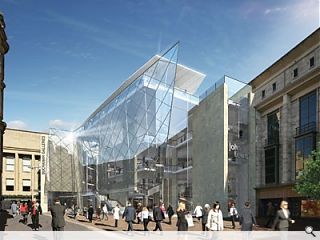The 3D urban model of Glasgow
25 Jun 2008
Planned to perfection
Greg Williamson, Director of Inlightin discusses how the impact of 3D Visualisation & the new 3D Urban Model of Glasgow is changing the design & planning process.
GLASGOW City Council's Development & Regeneration Services have commissioned the first accurate 3D Urban City Model to assist in the planning & development of the city. The model presently covers a considerable section of the city centre & the Clyde waterfront with plans to extend it in the future. A number of cities have attempted to construct 3D models of their urban fabric however, all have largely failed to create any lasting impression. What sets this city model apart from previous attempts can be found in its technical ingenuity and the foresight of how it will be integrated into the overall design & planning process.
To accurately capture the city urban fabric the new city model uses advanced laser scanning techniques. The ground team set up a number of scanners around a building or city block and the lasers produce a series of 3D cluster points which are then used as reference points in 3D space for creating the 3D model of the building - this allows the 3D model to be accurate within millimetres. High resolution photography is then taken of the building and texture mapped onto the geometry - the result is the most advanced photorealistic and accurate 3D model of any city centre in the world.
Our current understanding of the process at present allows for specific 'Zones' of the model to be purchased individually (for a 12 month lease) enabling design teams to incorporate their own 3D models into the virtual urban fabric. This workflow will enable informed design decisions & allow for as many design refinements as necessary prior to the planning submission. The design team can then produce as much media from the model as required to assess the design. The release date for the model is approximately September 2008, with cost for using the model still to be confirmed.
It is our understanding that once a planning submission has been approved, the planning department will request the proposed 3D model for inclusion into the Urban model. As the Urban model is in the 3D Studio Max 9 format, all new models will have to be optimised for that format. With most companies using a variety of software & skilled to various levels, how will the Development & Regeneration Services ensure that all new models arrive optimised to integrate with the Urban model? Maybe there has to be a filter of skilled 3D technicians refining the new models prior to overall integration with the Urban model? Not all companies will be equipped with the requisite hardware and software necessary to run the Urban model efficiently - this may result in larger architectural practices and specialist 3D companies being the first to comfortably implement & utilise the model.
Inlightin is one of the 3D visualisation studios and companies with the ability to do this as we not only have the hardware & software but also the experience and expertise in dealing with larger projects as demonstrated by our work on the extensive Commonwealth Games and National Indoor Sport Arena projects.
The long but rewarding path to understanding and working with 3D software and media enables design teams, clients & planners to successfully communicate in a much more effective and potent way than 2D drawings alone. It is no surprise that highly photorealistic imagery is increasingly being requested not only for marketing but also for the design and planning stages.
Advanced 3D media captures and communicates the corner stone languages of architectural design showing massing, scale, form, space, context, layout, lighting, material, colour, texture, presence and permanence.
There is no doubt that 3D visualisation is having a positive and enriching affect on the design and planning process. 3D tools like the Urban City Model and the high level of photo-realism in 3D images and animations being created by visualisation companies like Inlightin, are helping architects to better communicate their designs and helping planners better understand and more quickly assess the merits of new development proposals.
Greg Williamson
Managing Director, Inlightin



